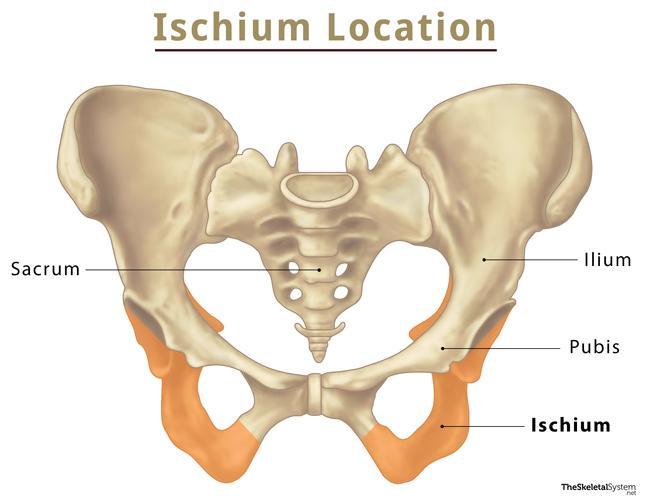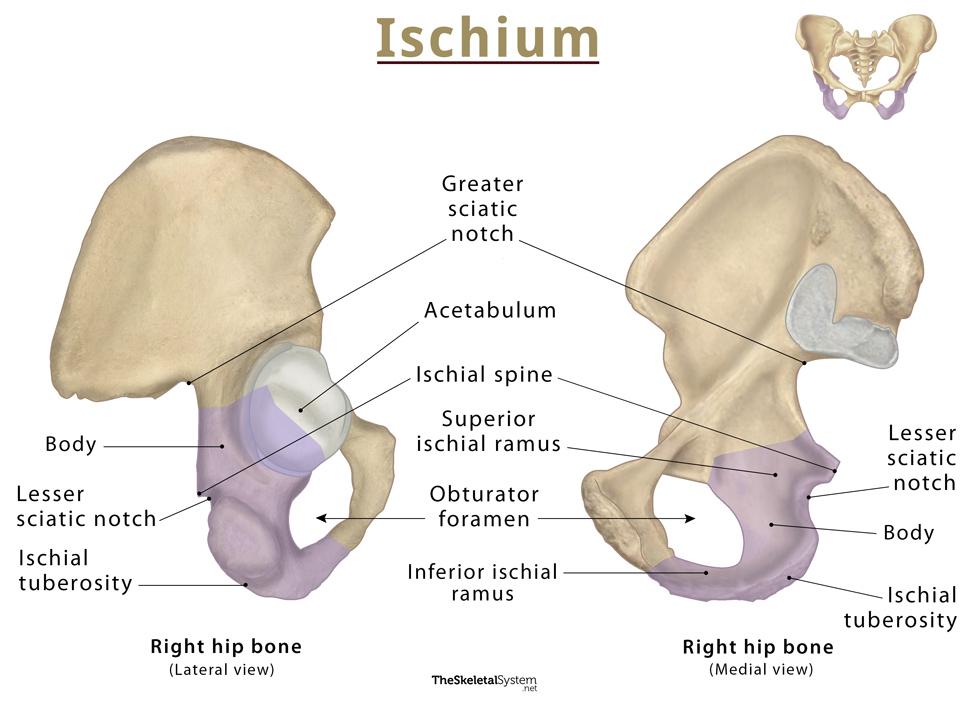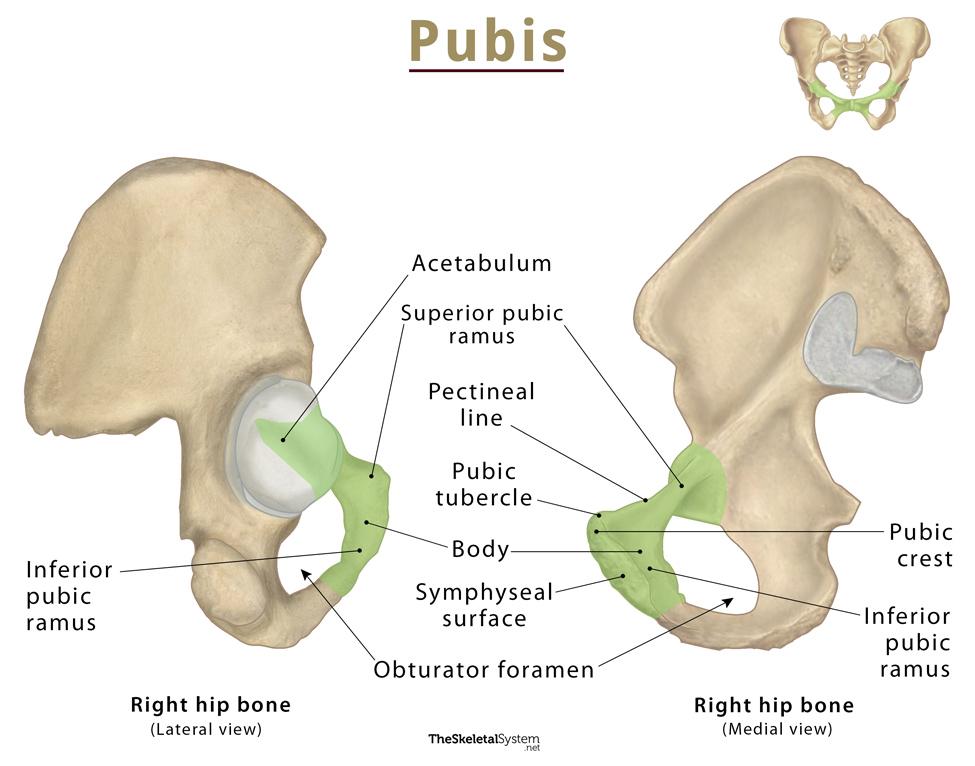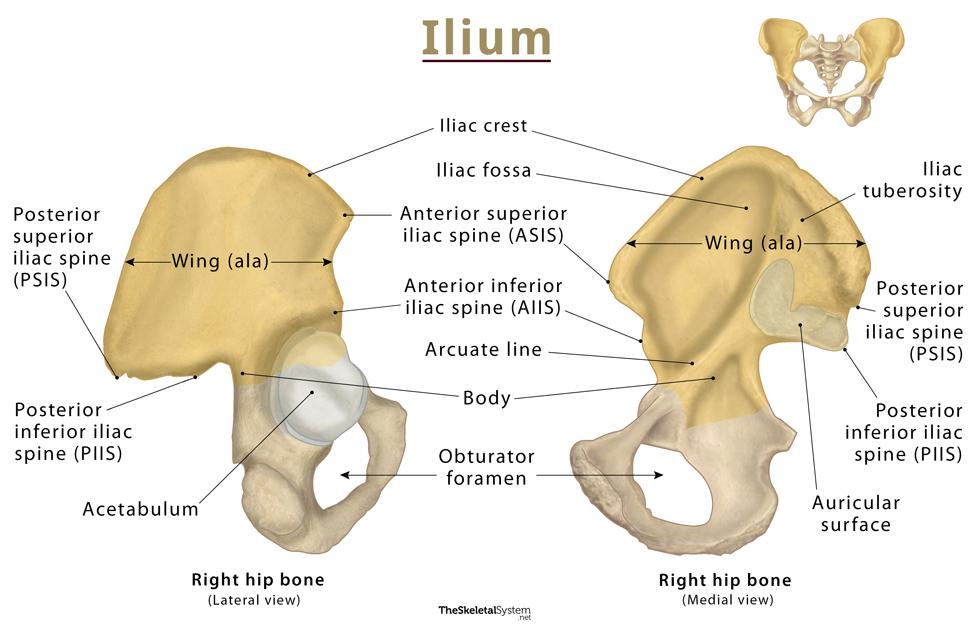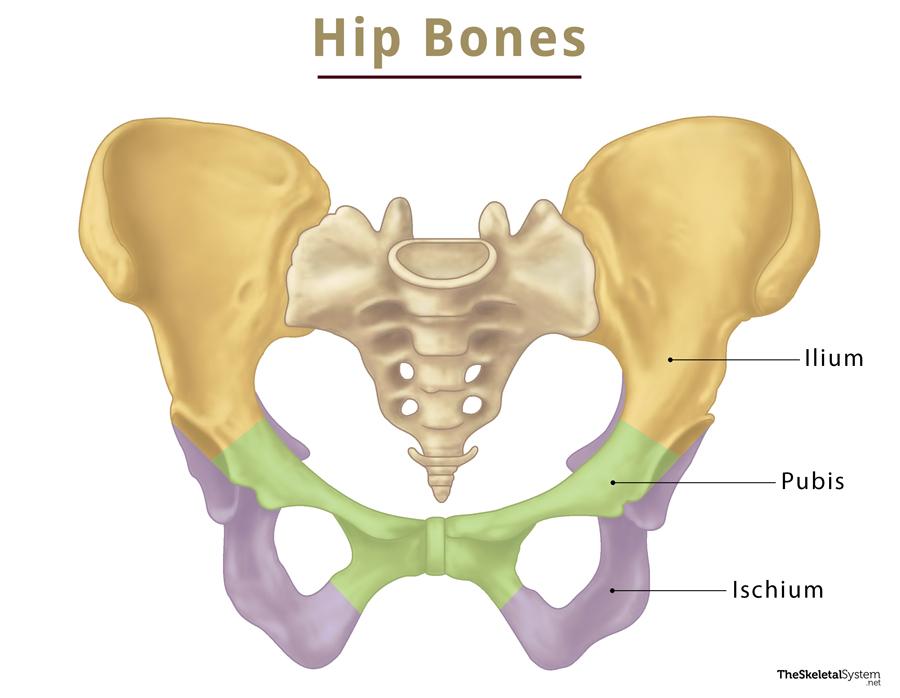Ischium
What is the Ischium
The ischium is one of the three bones of the hip bone, aside from the ilium and pubis. It forms the lower and back parts of the hip bone.
Where is the Ischium Bone Located
Ischium is located beneath the ilium and behind the pubis.
Quick Facts
| Type | Irregular Bone |
| How many are there in the human body | 2 (1 on each side) |
| Articulates with | Ilium and pubis |
Functions
- Being a part of the pelvis, it plays a great role in several body movements, such as walking and jogging.
- It is also essential in maintaining balance and an erect posture.
Ischium Anatomy, Parts, and Bony Landmarks
The ischium is divided into two main parts: the body and ramus. On the superior side, it forms the inferoposterior part of the acetabulum. On the inferior side, it ascends anteromedially at an acute angle and joins the descending pubic ramus, completing the obturator foramen.
Body
It is the largest portion of the bone, projecting superiorly to articulate with the ilium and the superior ramus of the pubis. These articulations lead to the formation of the acetabulum. The body of ischium constitutes a little more than two-fifths of the acetabulum. The external surface of the body forms a part of the lunate surface of the acetabulum and a portion of the acetabular fossa. On the other hand, the internal surface of the body forms a part of the wall of the lesser pelvis. The anterior border of the body projects as the posterior obturator tubercle. From the posterior border of the body, a thin and pointed triangular eminence, called ischial spine extends backwardly.
Ramus
The ischium has two rami, superior ramus and inferior ramus.
i. Superior Ramus: Extending inferiorly and posteriorly from the body, it is the partial origin site for the obturator internus and obturator externus muscles.
ii. Inferior Ramus: It is thin, flattened part of the ischium that extends anteromedially from the inferior side of the body and articulates with the inferior pubic ramus. These two rami together form the ischiopubic ramus, the inferior border of the obturator foramen.
Ischial Tuberosity
The posteroinferior side of the ischium features a large rounded bony prominence, called the ischial tuberosity. It is the site of attachment for several thigh muscles, the adductor magnus muscle, and the sacrotuberous ligament. The ischial tuberosities of the left and right hip bones support the whole body weight while sitting.
Ischial Spine
At the junction of the superior ramus and body, there is a conical bony projection, called the ischial spine, pointing posteromedially. The sacrospinous ligament attaches here, whereas the gemellus superior muscle originates from here. Parallel to the spine, there are two indentations:
i. Lesser sciatic notch: Located on the lower side of the ischial spine, specifically between the ischial tuberosity and the ischial spine.
ii. Greater sciatic notch: A larger notch, located on the upper side of the spine, that is, between the posterior inferior iliac spine and the ischial spine. The lesser sciatic notch gets converted into the lesser sciatic foramen by the sacrotuberous and sacrospinous ligaments.
Surfaces
The three surfaces of ischium are:
1. Medial Surface
As the name suggests, this flat, smooth surface faces the pelvic cavity and lies just above the ischioanal or ischiorectal fossa. It forms the lateral wall of the ischiorectal fossa. The obturator internus muscle and its fascia attach here.
2. Femoral Surface
As the name implies, this surface faces the head of the femur. On the anterior side, this surface is bounded by the posterior margin of the obturator foramen. On the other hand, its lateral side is delimited by the lateral border of the ischial tuberosity.
3. Posterior or Dorsal Surface
This surface is relatively smooth on its upper aspect. It runs alongside the iliac gluteal surface and forms the upper portion of the ischial tuberosity. The surface bears the greater and lesser sciatic notches, which remain separated by the ischial spine.
Articulations
The ischium fuses with the other two bones of the hip bone, the ilium and pubis. Hence, it does not form any joint.
Muscle and Ligament Attachments
The ischium provides numerous attachment points for pelvic and lower limb muscles, along with some important ligaments.
Muscle Attachments
Originating from ischium:
1. Superior gemellus: From the ischial spine.
2. Inferior gemellus: From the upper border of ischial tuberosity.
3. Semimembranosus: From the superolateral side of ischial tuberosity.
4. Biceps femoris long head and semitendinosus: From the inferomedial aspect of ischial tuberosity.
5. Adductor magnus: From the ischiopubic ramus and the inferolateral portion of the ischial tuberosity.
6. Obturator internus and obturator externus: From the superior part of the ramus.
7. Transverse perineal muscles: From the body of ischium.
8. Gracilis muscle: From the ischiopubic ramus.
9. Piriformis muscle: From the superior aspect of the greater sciatic notch.
Inserting into the ischium:
1. Coccygeus and levator ani muscles: At the ischial spine.
Ligament Attachments
1. Sacrospinous ligament: Attaches to the ischial spine, and runs from the ischial spine to the sacrum.
2. Sacrotuberous ligament: Attaches to the posterior iliac spine and medial ischial tuberosity, and travels from the sacrum to the ischial tuberosity, forming the lesser sciatic foramen.
References
- Ischium – Med.libretexts.org
- Ischium – Radiopaedia.org
- The Hip Bone – Teachmeanatomy.info
- Hip bone – Kenhub.com
- Bony pelvis – Kenhub.com

